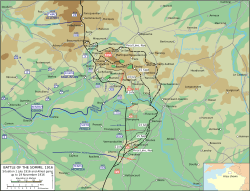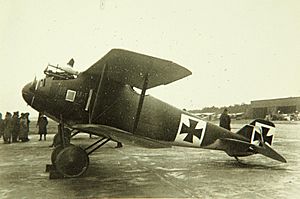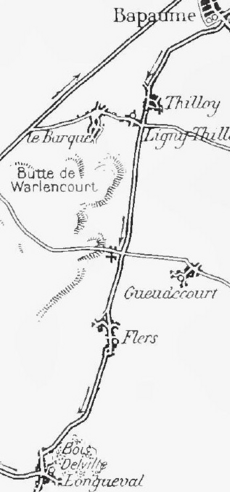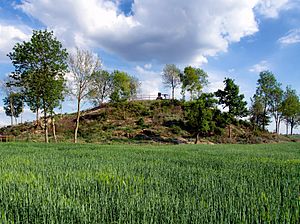Attacks on the Butte de Warlencourt facts for kids
Quick facts for kids Attacks on the Butte de Warlencourt |
|||||||
|---|---|---|---|---|---|---|---|
| Part of The Battle of the Somme, First World War | |||||||
 The Battle of the Somme 1 July – 18 November 1916 |
|||||||
|
|||||||
| Belligerents | |||||||
| Commanders and leaders | |||||||
| Douglas Haig Henry Rawlinson |
Crown Prince Rupprecht | ||||||
| Strength | |||||||
| parts of 6 divisions | |||||||
The Attacks on the Butte de Warlencourt were a series of battles during the Battle of the Somme in 1916. The Butte de Warlencourt is an old burial mound in northern France. It's located near the towns of Albert and Bapaume. During the First World War, German soldiers built strong defenses inside the Butte. They dug deep tunnels and surrounded it with lots of barbed wire. This made it a very tough place to attack.
The Butte was important because it offered a great view of the British front line. German troops used it to watch British movements and direct their artillery fire. British forces tried many times to capture the Butte, but they failed. The Germans held onto it, making these attacks a German victory. Later, the Butte changed hands a few more times before the war ended. Today, the site is preserved to remember the soldiers who fought there.
Why the Butte was Important
The War in 1914
In September 1914, early in the war, German and French armies were trying to outflank each other. This period was called the "Race to the Sea." German forces pushed through parts of France, including the Somme region. They wanted to reach the coast. French troops fought back hard to stop them. The area around the Butte de Warlencourt became part of the front line.
The War in 1916
By 1916, the Butte de Warlencourt was a key German stronghold. British planes from the Royal Flying Corps (RFC) flew over the area. They spotted new German trenches and defenses. There were even dogfights in the sky above the Butte. In one fight, three German planes were shot down.
British troops slowly gained ground around the Butte. They captured a ruined mill and a farm nearby. This allowed them to move their big guns closer. These guns could then fire on the Butte. German soldiers defending the Butte faced very tough conditions. They were cold, hungry, and constantly under fire. Many got sick, and their morale was low.
Getting Ready for Battle
German Defenses

The Butte is a hill about 50 to 60 feet high. It was a perfect spot for defense. The Germans had already dug tunnels there during an earlier war. For the Battle of the Somme, they made it even stronger. They added machine-gun posts and many layers of barbed wire. From the Butte, German soldiers could see for miles. They also set up many artillery positions nearby. This allowed them to fire accurately at British forces.
British Plans
The British planned a big attack on the German lines. The 47th (1/2nd London) Division was to lead the main attack. Other divisions would support them. Their goal was to capture the Gird trenches and the Butte itself. They planned to attack in the afternoon on October 7. The British troops prepared their positions. They also brought in more soldiers to help with the attack.
The Battle Begins
October 7 Attack
The attack started on October 7. British soldiers faced heavy machine-gun fire right away. Many were stopped before they could reach their goals. Some brave soldiers managed to get very close to the Butte. But they were never seen again. The Germans had excellent views of the attacking British. This allowed them to fire very accurately.
Some British troops managed to dig in. They set up small outposts. German soldiers launched several counter-attacks. The fighting was fierce. The British suffered many casualties. They had to bring in fresh troops to replace the fallen.
On October 8, British planes spotted a German post near the Butte. The British attacked again that night. They tried to rush the German trenches after a short, intense artillery barrage. Some troops reached the trenches, but heavy machine-gun fire stopped most of them. The survivors dug new positions closer to the German lines. After these attacks, two British divisions were replaced by Scottish divisions. They prepared for another try.
October 12 Attack
The Scottish divisions took over for the next attack on October 12. The weather was bad, making it hard to see. German forces were tired, but they still had many machine guns. The British aimed to capture Snag Trench and the Butte. They also planned to use smoke screens to hide their advance.
When the attack began, British artillery fired too short. This meant their own shells hit their soldiers. Machine-gun fire from the Germans also stopped the advance. Only a small amount of ground was gained. On the left side, South African troops got lost in the smoke. They were also stopped by heavy fire. The German defenders held their ground. They had suffered many losses but still fought hard.
October 18 Attack
On October 17, a British tank appeared. It fired on German positions, causing panic. The Germans called it a "gigantic iron dragon." The British planned another attack for October 18. The weather was terrible, with heavy rain. The ground turned into deep mud.
Despite the conditions, some British soldiers reached Snag Trench. They forced the Germans back. But German counter-attacks soon began. The fighting was very difficult in the mud. On the left side, South African troops faced uncut barbed wire. They were then hit by machine-gun fire. Most of them were lost. Only a few returned. The mud was so deep that moving just 1,000 yards took four hours. The British tried another attack, but it was called off. The ground was too difficult.
November 5 Attack
The 50th (Northumbrian) Division took over the front lines in late October. The rain continued, making the ground very swampy. Attacks were delayed many times. Finally, on November 5, the attack was set for 9:10 a.m. The soldiers had to wade through mud that was sometimes thigh-deep. Some men even drowned.
When the attack started, British soldiers followed their artillery barrage. But German machine guns fired from the sides. This caused many casualties. Some British troops got close to the Butte. But they were hit by their own artillery fire. On the right, an Australian attack failed. Their artillery also fired behind their own lines.
In the center, British troops captured part of Gird Trench. On the left, they took a quarry and the Butte itself. They set up a machine-gun position. But German counter-attacks began in the afternoon. The fighting for the Butte continued. By the next morning, the British were pushed back to their starting lines. The Germans had retaken the Butte. The British suffered about 1,000 casualties in this attack.
After the Battle
Casualties
The battles for the Butte de Warlencourt were very costly.
- From October 12 to 24, the 9th (Scottish) Division lost 3,255 soldiers.
- In the November 5 attack, the 50th (Northumbrian) Division lost about 1,000 soldiers.
Later Operations
November 14
The rain stopped for a few days, but then returned. The ground was still very muddy. On November 14, the British tried another local attack. They aimed to capture more trenches. But the conditions were terrible. German machine-gun fire from the Butte was very strong. Many attackers disappeared in the mist and mud. German counter-attacks pushed the British back again. By November 16, the Germans had recaptured Gird Trench.
Raid in January 1917
In January 1917, British soldiers launched a surprise raid on the Butte. They wore white clothes and helmets to blend in with the snow. They moved quietly across no man's land. The attack began with a short artillery barrage. The raiders met little resistance. They captured some German prisoners and destroyed dugouts. At the Butte, 12 Germans surrendered. When others refused, bombs were thrown into the tunnels. A fire started inside the Butte. The British raiders returned to their lines after about 25 minutes. They had 17 casualties. Later, a large explosion was seen at the Butte. Flames rose, and exploding ammunition was heard.
February 1917
On February 24, 1917, the 2nd Australian Division finally occupied the Butte de Warlencourt. This happened because the Germans were pulling back their forces. They were moving to a new, stronger defensive line called the Hindenburg Line.
1918
The Butte de Warlencourt was recaptured by the German army on March 24, 1918. This was during a big German attack called Operation Michael. But the Butte was taken back by the British for the last time on August 26, 1918. This happened during the Second Battle of Bapaume.
Remembering the Butte
Paintings
The famous war artist William Orpen visited the Somme battlefield in 1917. He painted the Butte de Warlencourt. He described it as "pale gold against the eastern sky." He also imagined what it looked like in winter, with soldiers in white raiding it. Another artist, Christopher R. W. Nevinson, also drew the Butte. These artworks help us remember the battles fought there.
Saving the Butte
The land where the Butte de Warlencourt stands was bought in 1990. The Western Front Association bought it to preserve it. They wanted to make sure the site was protected. Memorials were put up on the Butte to honor the soldiers who fought there. In 2018, there was a plan to sell the land. But after people raised concerns, it was offered back to the Western Front Association. This shows how important it is to remember these historical places.




